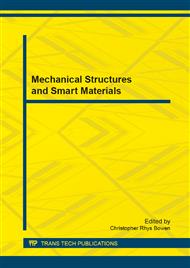p.195
p.199
p.204
p.210
p.214
p.218
p.225
p.230
p.234
Interaction Relationship Analysis of Surface Roughness on Aluminium Etched Wafer Using RIE
Abstract:
This paper presents the interaction relationships between Tetrafluoromethane (CF4) gas, Oxygen (O2) gas, and RF power in response to the surface roughness of an Aluminium deposited wafer after being etched using Reactive Ion Etching (RIE). The investigation was done using the three factors full factorial design of experiment (DOE). Analysis was done qualitatively by plotting the main interaction plots. The results suggest that strong interactions are present between CF4 and RF power, CF4 and O2, and also O2 and RF power due to the intersection of the graphs. This implies that all three factors have interaction between each other towards the surface roughness on the deposited Aluminium after RIE.
Info:
Periodical:
Pages:
214-217
Citation:
Online since:
January 2014
Price:
Сopyright:
© 2014 Trans Tech Publications Ltd. All Rights Reserved
Share:
Citation:


